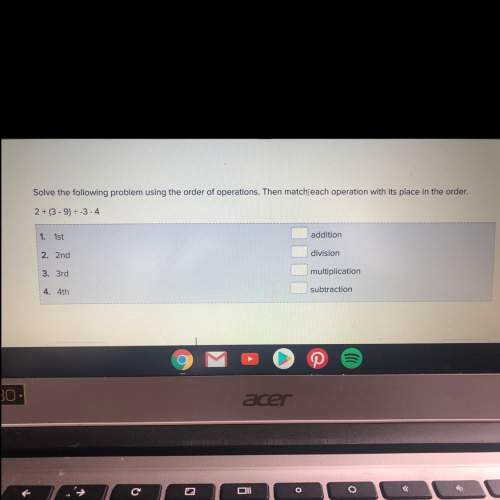
Mathematics, 16.04.2021 17:10 bburpee1
In an effort to test the hypothesis that the proportion of voters in the younger than 40 year old age bracket who will vote for a particular politician is different than the proportion voters in the above 40 age bracket, the following data was collected. Test hypothesis at 0.10 level of significance.
Population Number Who Will Vote for Politician Sample Size
Below 40 348 700
Above 40 290 650
Required:
a. Reject the Null Hypothesis and condlude that the proportion of voters in the younger than 40 year oid age bracket who will vote for a particular different than the proportion voters in the above 40 age bracket.
b. Do not reject the Null Hypothesis and conclude that the proportion of wotors in the younger than 40 year old age bracket who will vote for a particular politician is not different than the proportion voters in the above 40 age bracket.

Answers: 3
Another question on Mathematics


Mathematics, 21.06.2019 18:50
The random variable x represents the number of phone calls an author receives in a day, and it has a poisson distribution with a mean of 8.7 calls. what are the possible values of x
Answers: 1

Mathematics, 21.06.2019 20:00
Someone answer asap for ! a discount store’s prices are 25% lower than department store prices. the function c(x) = 0.75x can be used to determine the cost c, in dollars, of an item, where x is the department store price, in dollars. if the item has not sold in one month, the discount store takes an additional 20% off the discounted price and an additional $5 off the total purchase. the function d(y) = 0.80y - 5 can be used to find d, the cost, in dollars, of an item that has not been sold for a month, where y is the discount store price, in dollars. create a function d(c(x)) that represents the final price of an item when a costumer buys an item that has been in the discount store for a month. d(c(x)) =
Answers: 1

Mathematics, 21.06.2019 20:30
Explain how you divide powers with like bases.discuss why the bases have to be the same.how are these rules similar to the rules for multiplying powers with like bases.
Answers: 1
You know the right answer?
In an effort to test the hypothesis that the proportion of voters in the younger than 40 year old ag...
Questions

Mathematics, 01.08.2019 19:20






Biology, 01.08.2019 19:20


Biology, 01.08.2019 19:20

Biology, 01.08.2019 19:20

Biology, 01.08.2019 19:20


Biology, 01.08.2019 19:20

Biology, 01.08.2019 19:20

Biology, 01.08.2019 19:20


Mathematics, 01.08.2019 19:20

English, 01.08.2019 19:20

English, 01.08.2019 19:20

English, 01.08.2019 19:30




